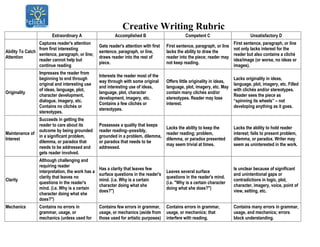
Creative writing rubric(2)
- 1. Creative Writing Rubric Extraordinary A Accomplished B Competent C Unsatisfactory D Ability To Catch Attention Captures reader's attention from first interesting sentence, paragraph, or line; reader cannot help but continue reading Gets reader's attention with first sentence, paragraph, or line, draws reader into the rest of piece. First sentence, paragraph, or line lacks the ability to draw the reader into the piece; reader may not keep reading. First sentence, paragraph, or line not only lacks interest for the reader but also contains a cliché idea/image (or worse, no ideas or images). Originality Impresses the reader from beginning to end through original and interesting use of ideas, language, plot, character development, dialogue, imagery, etc. Contains no clichés or stereotypes. Interests the reader most of the way through with some original and interesting use of ideas, language, plot, character development, imagery, etc. Contains a few clichés or stereotypes. Offers little originality in ideas, language, plot, imagery, etc. May contain many clichés and/or stereotypes. Reader may lose interest. Lacks originality in ideas, language, plot, imagery, etc. Filled with clichés and/or stereotypes. Reader sees the piece as “spinning its wheels” – not developing anything as it goes. Maintenance of Interest Succeeds in getting the reader to care about its outcome by being grounded in a significant problem, dilemma, or paradox that needs to be addressed and gets reader involved. Possesses a quality that keeps reader reading--possibly, grounded in a problem, dilemma, or paradox that needs to be addressed. Lacks the ability to keep the reader reading; problem, dilemma, or paradox presented may seem trivial at times. Lacks the ability to hold reader interest; fails to present problem, dilemma, or paradox. Writer may seem as uninterested in the work. Clarity Although challenging and requiring reader interpretation, the work has a clarity that leaves no questions in the reader's mind. (i.e. Why is a certain character doing what she does?") Has a clarity that leaves few surface questions in the reader's mind. (i.e. Why is a certain character doing what she does?") Leaves several surface questions in the reader's mind. (i.e. "Why is a certain character doing what she does?") Is unclear because of significant and unintentional gaps or contradictions in logic, plot, character, imagery, voice, point of view, setting, etc. Mechanics Contains no errors in grammar, usage, or mechanics (unless used for Contains few errors in grammar, usage, or mechanics (aside from those used for artistic purposes) Contains errors in grammar, usage, or mechanics; that interfere with reading. Contains many errors in grammar, usage, and mechanics; errors block understanding.
